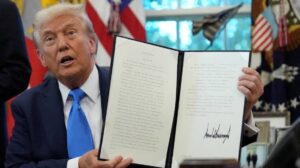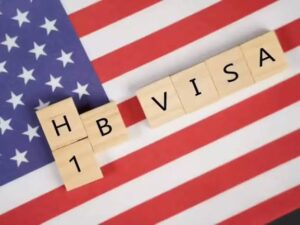Digital News Guru National Desk:
U.S. H-1B Visa Overhaul: $100,000 Fee and Its Implications for Indian Applicants
In a major shake-up of the U.S. work-visa regime, the H‑1B visa programme—widely used by skilled foreign workers, particularly from India—has been hit with a dramatic new fee. On September 19 2025, U.S. President Donald Trump signed a proclamation titled “Restriction on Entry of Certain Nonimmigrant Workers” that introduced a supplemental one-time fee of US $100,000 per petition filed for H-1B status.
The fee is designed to apply to new H-1B petitions filed on or after 12:01 a.m. (ET) on September 21, 2025, and is targeted at petitions for beneficiaries who are currently outside the U.S. at the time of filing. The White House clarified that the fee is not annual but a one-time payment tied to the petition.

However — and importantly — key categories of applicants have been exempted from the fee: existing H-1B visa‐holders, those seeking renewals, and beneficiaries already in the U.S. and changing status, are not required to pay the $100,000 fee.
For the Indian tech worker and student community, which has long relied on the H-1B visa pathway, the news is a mix of concern and relief.
Why India & Indian Tech Workers Are Particularly Affected
India has traditionally been the predominant source of H-1B visa beneficiaries in the U.S. For example, in only one recent year more than 70 percent of H-1B visas went to Indian nationals. Large Indian IT services firms such as Tata Consultancy Services, Infosys and Wipro rely heavily on sending staff to the U.S. on H-1B visas for client projects.
Hence, the introduction of a $100,000 fee for new H-1B filings raised immediate alarm in India’s IT sector. The fee, if broadly applied, could significantly raise the cost of hiring and deploying foreign tech talent in the U.S., and potentially reduce the number of places for Indian professionals. The Indian government’s foreign-ministry described the fee hike as likely to have “humanitarian consequences … by way of the disruption caused for families”.
Technology firms, already operating on tight margins for deployment and travel, were quick to sound caution. Large U.S. tech companies reportedly urged H-1B employees not to travel abroad and to stay in the U.S. in the days following the announcement.
Relief Measures & Clarifications
Following the announcement, the U.S. Citizenship and Immigration Services (USCIS) and the White House issued clarifications that provide relief for many existing visa‐holders and Indian students. Key points include:
- The $100,000 fee applies only to new petitions filed after September 21 2025. It does not apply to existing H-1B visa holders, renewals, or extensions.

- The fee applies to beneficiaries outside the U.S. at time of filing. If a candidate is already in the U.S. and switching status (for example, F-1 to H-1B), the fee may not apply.
- Indian IT body NASSCOM welcomed the clarification, saying it had “eased uncertainty” for Indian companies and that only a marginal impact was expected given that many firms had already pivoted away from heavy reliance on H-1B immigration.
One illustration: For Indian students already in the U.S. on F-1 status and planning to apply for H-1B through change of status (within the U.S.), the process remains unaffected by the $100,000 fee — offering a clear relief path.
Implications & Strategic Shifts
While the clarifications offer relief, the fee change still signals a significant shift in U.S. visa policy, with broader implications:
- Companies may reconsider sponsoring new H-1B visa recipients abroad, especially younger or mid-level tech workers, since the increased cost becomes a major factor. This could reduce the opportunities for foreign nationals to be deployed to the U.S. and prompt more on-shore hiring instead of overseas transitions.
- Indian tech firms may accelerate their focus on hiring locally in the U.S., skilling U.S.-based employees, or shifting more work to India rather than deploying staff on H-1Bs. Indeed, NASSCOM noted Indian IT firms already spend over US $1 billion on U.S. local up-skilling and hiring.
- Indian students who intend to go to the U.S. for higher education with the goal of transitioning to H-1B work status must now pay closer attention to whether they will change status within the U.S. or travel and apply from abroad (which could trigger the fee).
- The business and legal community in the U.S. is also pushing back: the U.S. Chamber of Commerce has filed a lawsuit challenging the fee, arguing it exceeds the executive branch’s authority and could harm businesses that rely on global talent.
What Tech Workers & Students in India Should Do
For Indian students and tech professionals evaluating U.S. work or study plans, the following steps are now especially prudent:
- If you’re already in the U.S. on F-1 or other status, and your employer plans to file for H-1B change of status without requiring you to depart the U.S., you should be protected from the $100,000 fee — but check with immigration counsel.
- Avoid travel abroad prematurely if you’re on H-1B or applying for it, since leaving the U.S. may convert your case into consular processing (outside the U.S.), which could trigger the fee.
- If you’re outside the U.S., planning to apply for your first H-1B visa, anticipate the high cost and discuss with your employer how the $100,000 fee will be handled. Some employers may reduce sponsorship or shift to other pathways.
- Monitor policy changes and industry reactions. The policy is scheduled to expire after one year unless extended; litigation may alter the outcome; and U.S. business strategies will adjust.
- Consider diversification of global opportunities: With U.S. pathways becoming costlier, alternative destinations (Canada, Australia, Germany) or remote-work models may get more attention among Indian tech professionals and students.
Looking Ahead
The $100,000 fee announcement marks one of the most dramatic transformations in the H-1B visa programme in decades. Its intent — to ensure that only highly paid, highly skilled workers are sponsored and to “protect” U.S. workers — is clear, even as critics warn of the adverse effect on innovation, global talent inflows and U.S. competitiveness.
For India’s tech sector and student community, the immediate damage has been softened by clarifications from the White House and USCIS. Existing visa holders and those switching status inside the U.S. largely retain their path forward without the added fee. Yet, the structure of U.S. immigration for skilled workers is shifting, and the long‐term implications remain significant: companies may change hiring strategies, students may recalibrate expectations, and the cost of U.S. employment for foreign workers may effectively rise.
As the dust settles, stakeholders on both sides of the Atlantic—students, employers, governments—will be watching closely. For Indian students with U.S. aspirations and tech workers aiming for global mobility, understanding the fine print of status, petition filing location, and whether the fee will apply is now more important than ever.
You May Also Read: Veteran actor-director Asrani passes away at age 84








